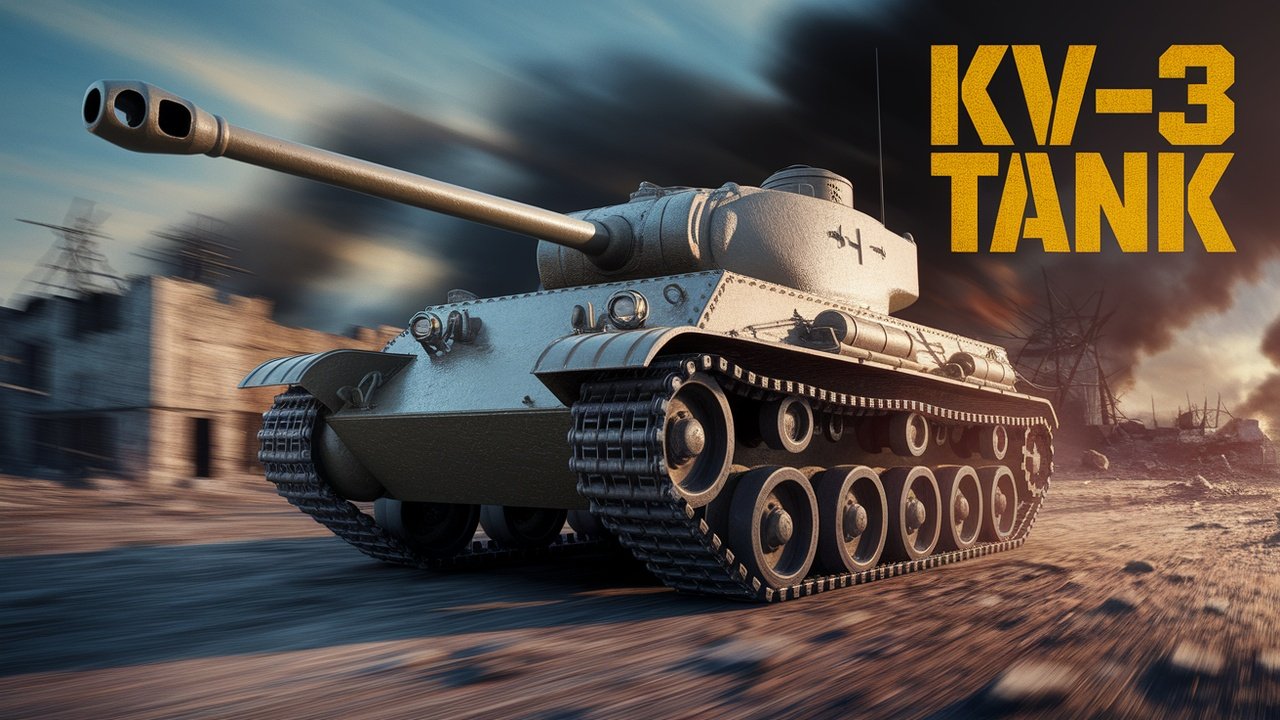The KV-3 Heavy Tank: A Forgotten Giant of Soviet Armor

Introduction:
In the world of World War II-era armored warfare, a few KV-3 legendary names come to mind—Tigers, Shermans, and T-34s. But nestled in the shadows of these famed steel behemoths is a lesser-known yet equally ambitious machine: the KV-3. Developed as part of the Soviet Union’s response to the rapid escalation of German armor power, the KV-3 was envisioned as a super-heavy tank that would outmatch anything the Axis forces could deploy.
Despite never reaching mass production or seeing frontline combat, the KV-3 remains a fascinating example of wartime engineering ambition and strategic planning. In this deep dive, we’ll explore the development, specifications, historical context, and legacy of the KV-3 heavy tank, unraveling the story of what could have been one of the most powerful tanks of the Second World War.
1. Background and the Birth of the KV Series
The KV series of tanks (named after Soviet defense commissar Kliment Voroshilov) represented a significant leap in Soviet tank design. Beginning with the KV-1, these tanks were characterized by their heavy armor and firepower. When Germany launched Operation Barbarossa in 1941, the KV-1 and KV-2 demonstrated their resilience, often withstanding numerous hits from German anti-tank weapons.
However, the appearance of newer, more potent German tanks like the Panzer IV F2 and later the Tiger I prompted Soviet designers to look for something even more formidable. This is where the idea of the KV-3 was born—a tank that could outgun and outlast anything the Germans fielded.
2. The Concept of the KV-3: Super Heavy Ambitions
The KV-3 was part of the Soviet Union’s response to reports of increasing German tank armor and firepower. It was meant to be the next generation of the KV line, larger and more powerful than the KV-1 and KV-2. Initially proposed in 1940, it was supposed to serve as a breakthrough tank—an unstoppable battering ram designed to smash through enemy defenses.
Primary objectives for the KV-3 included:
- Heavier armor than any known German tank
- A powerful high-velocity cannon
- Stronger and more reliable suspension and drivetrain
- A psychological edge over enemy forces
With these ambitions came design challenges that ultimately slowed its development.
3. Design Specifications of the KV-3

The KV-3 was envisioned with imposing technical specifications that, on paper, made it one of the most intimidating tanks of its time.
Planned specifications included:
- Weight: Approximately 68-70 tons
- Armor: Up to 120 mm frontal armor (with the possibility of further upgrades)
- Main Armament: Initially a 107mm ZiS-6 gun (or alternately, the F-42)
- Secondary Armament: Multiple 7.62 mm DT machine guns
- Engine: A 1,200-horsepower V-2SN diesel engine
- Top Speed: Estimated 30 km/h on roads
- Crew: 6-7
These features placed the KV-3 squarely in the super-heavy tank category, which came with significant engineering trade-offs.
4. Challenges in Development
One of the primary hurdles facing the KV-3 project was the Soviet industrial base itself. In 1941, the USSR was still grappling with modernization and wartime resource allocation. A tank weighing over 70 tons required specialized components—transmissions, engines, tracks, and suspension systems—that were difficult to produce, especially under the pressure of war.
Key developmental issues included:
- Difficulty scaling up the engine power without overheating
- Track failure under heavy loads
- Transportability across bridges and railway systems
- Logistical burdens on repair, refueling, and ammunition
Moreover, the rapid German advance into Soviet territory in 1941 forced the relocation of many tank factories, including the Kirov Plant, which was developing the KV-3. This disruption further delayed the project.
5. The Fall of the KV-3 Project

Despite its promise, the KV-3 never made it past the prototype stage. In mid-1941, as German panzers surged into Soviet territory, priorities shifted dramatically. The Soviet Union needed tanks that could be produced quickly and in large numbers. The T-34, which was simpler, cheaper, and faster to manufacture, became the workhorse of the Red Army.
By late 1941, the KV-3 project was canceled. Efforts and resources were redirected toward improving existing models (like the KV-1S) and eventually transitioning to the IS (Iosif Stalin) series of heavy tanks.
6. Comparing the KV-3 to Other Tanks of the Era
While the KV-3 never saw combat, its theoretical capabilities offer a compelling basis for comparison to other contemporary tanks.
KV-3 vs. Tiger I:
- Armor: KV-3 was intended to have similar or even superior frontal armor.
- Gun: Both had high-velocity cannons, though the Tiger’s 88mm was proven in battle.
- Mobility: Tiger I had better real-world reliability; KV-3’s mobility was untested.
KV-3 vs. T-34:
- The T-34 was far more agile, less costly, and became the backbone of the Soviet tank corps.
- KV-3 had superior protection and firepower, but lacked the practicality of mass production.
7. Legacy and Influence on Future Designs
Though the KV-3 was a dead-end project, it laid important groundwork for future heavy tank designs. Many of its proposed features—thicker armor, more powerful guns, and larger crew compartments—were integrated into the IS series, particularly the IS-2, which proved to be one of the most successful Soviet heavy tanks of WWII.
Additionally, the KV-3 provided valuable engineering data. Experiments with the 107mm gun influenced future Soviet artillery development, and the drivetrain issues informed the design of more robust suspension systems in later vehicles.
8. Modern Interpretations and Wargaming Fame
Today, the KV-3 has gained a sort of cult status among tank enthusiasts, largely thanks to video games and simulations like World of Tanks, where it appears as a Tier 7 heavy tank. In such games, players get to experience what it might have been like to command this armored monster on the battlefield.
In the gaming context, the KV-3 is known for:
- High durability and armor thickness
- Powerful, slow-firing guns
- Sluggish speed and poor maneuverability
These virtual attributes mirror its real-world design goals, making it a fan favorite for those who appreciate tank history.
9. Why the KV-3 Still Matters Today
The KV-3 symbolizes a pivotal moment in Soviet military thinking—when overwhelming armor and firepower were seen as key to victory, even at the cost of mobility and logistical complexity. Its story reflects the broader tension in tank design between ideal battlefield dominance and practical wartime production.
Military historians continue to study the KV-3 to understand:
- Soviet engineering capabilities in the early 1940s
- Decision-making in tank production during wartime
- The balance between innovation and feasibility
10. Conclusion: A Monument to What Might Have Been
The KV-3 heavy tank stands as a testament to ambition, innovation, and the harsh realities of war. Though it never roared across battlefields or fired a shot in anger, it occupies an important place in armored warfare history. The lessons learned from its development helped shape the Soviet Union’s future tank doctrine and contributed to the emergence of tanks that would eventually help turn the tide of the war.
In the end, the KV-3 may not have been a war hero, but it was a pioneer—a bold, if unrealized, step in the evolution of tank design.





